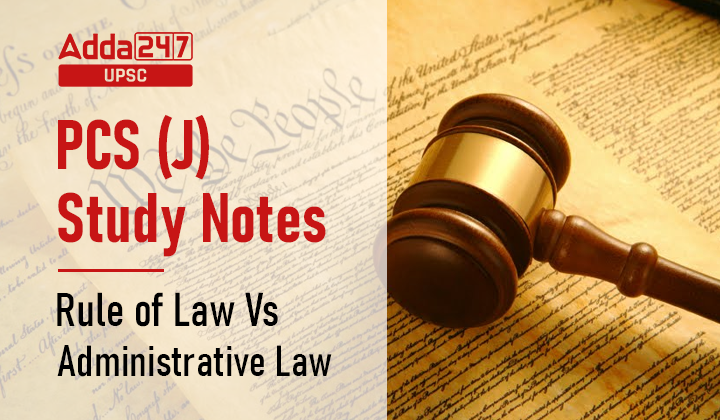Table of Contents
Difference between Rule of Law & Administrative Law
The rule of law is a cornerstone of administrative law theory. One of the concepts that slowed down the maturation of Administrative Law was this one. Yet another bit of irony is that current Administrative Law places much emphasis on the rule of law. In India, the rule of law has served as the foundation for both administrative action and judicial scrutiny. Supreme Court has advocated for this concept in numerous cases, including Bachan Singh v. State of Punjab and A.D.M. Jabalpur.
Dicey defined rule of Law as the “absolute supremacy or predominance of regular law as opposed to the influence of arbitrary power and excludes the existence of prerogatives or even wide discretionary power on the part of government”.
The principle states that all people living in a given country should be treated equally by the law. That is to say, no class of individuals is immune from the protections of administrative law. Furthermore, it cannot discriminate against any section of the population. The rule of law has an effect on government agencies in that the rules and regulations they establish must be implemented uniformly to all individuals. It violates the rule of law to speed up or slow down this procedure for particular persons.
In contrast, administrative law is the body of law that regulates how government bureaus and other bureaucratic bodies perform their functions. Agency internal operations and dealings with the public are governed by the rules laid out in this statute. Administrative law provides a framework upon which the actions of law administrators and enforcers can be established. One of the main goals of administrative law is to maximise public access to information about how government bodies actually operate.
Dicey distinguished administrative action and discretion from rule of law, arguing that the latter implies the existence of arbitrary power and the former the absence of it.
कानून के शासन और प्रशासनिक कानून के बीच अंतर
कानून का शासन प्रशासनिक कानून सिद्धांत की आधारशिला है। प्रशासनिक कानून की परिपक्वता को धीमा करने वाली अवधारणाओं में से एक यह थी। फिर भी एक और विडंबना यह है कि वर्तमान प्रशासनिक कानून कानून के शासन पर अधिक जोर देता है। भारत में, कानून के शासन ने प्रशासनिक कार्रवाई और न्यायिक जांच दोनों की नींव के रूप में कार्य किया है। सुप्रीम कोर्ट ने बचन सिंह बनाम पंजाब राज्य और ए डी एम जबलपुर सहित कई मामलों में इस अवधारणा की वकालत की है।
डाइसी ने कानून के शासन को “मनमाने शक्ति के प्रभाव के विपरीत नियमित कानून की पूर्ण सर्वोच्चता या प्रबलता के रूप में परिभाषित किया और सरकार की ओर से विशेषाधिकार या व्यापक विवेकाधीन शक्ति के अस्तित्व को बाहर कर दिया”।
सिद्धांत कहता है कि किसी दिए गए देश में रहने वाले सभी लोगों के साथ कानून द्वारा समान व्यवहार किया जाना चाहिए। कहने का तात्पर्य यह है कि व्यक्तियों का कोई भी वर्ग प्रशासनिक कानून के संरक्षण से अछूता नहीं है। इसके अलावा, यह आबादी के किसी भी वर्ग के साथ भेदभाव नहीं कर सकता है। कानून के शासन का सरकारी एजेंसियों पर प्रभाव पड़ता है कि उनके द्वारा स्थापित नियमों और विनियमों को सभी व्यक्तियों के लिए समान रूप से लागू किया जाना चाहिए। यह विशेष व्यक्तियों के लिए इस प्रक्रिया को तेज या धीमा करने के लिए कानून के शासन का उल्लंघन करता है।
इसके विपरीत, प्रशासनिक कानून कानून का निकाय है जो यह नियंत्रित करता है कि सरकारी ब्यूरो और अन्य नौकरशाही निकाय अपने कार्य कैसे करते हैं। एजेंसी के आंतरिक संचालन और जनता के साथ व्यवहार इस क़ानून में निर्धारित नियमों द्वारा शासित होते हैं। प्रशासनिक कानून एक ढांचा प्रदान करता है जिस पर कानून प्रशासकों और प्रवर्तकों के कार्यों को स्थापित किया जा सकता है। प्रशासनिक कानून के मुख्य लक्ष्यों में से एक यह है कि सरकारी निकाय वास्तव में कैसे काम करते हैं, इस बारे में जानकारी तक सार्वजनिक पहुंच को अधिकतम करना है।
डाइसी ने प्रशासनिक कार्रवाई और विवेक को कानून के शासन से अलग किया, यह तर्क देते हुए कि उत्तरार्द्ध का अर्थ है मनमानी शक्ति का अस्तित्व और पूर्व में इसकी अनुपस्थिति।



 TSPSC Group 1 Question Paper 2024, Downl...
TSPSC Group 1 Question Paper 2024, Downl...
 TSPSC Group 1 Answer key 2024 Out, Downl...
TSPSC Group 1 Answer key 2024 Out, Downl...
 UPSC Prelims 2024 Question Paper, Downlo...
UPSC Prelims 2024 Question Paper, Downlo...





